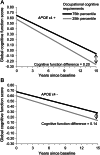Occupational cognitive requirements and late-life cognitive aging
- PMID: 26984944
- PMCID: PMC4831043
- DOI: 10.1212/WNL.0000000000002569
Occupational cognitive requirements and late-life cognitive aging
Abstract
Objective: To examine whether occupational cognitive requirements, as a marker of adulthood cognitive activity, are associated with late-life cognition and cognitive decline.
Methods: Main lifetime occupation information for 7,637 participants aged >65 years of the Chicago Health and Aging Project (CHAP) was linked with standardized data on worker attributes and job characteristics from the Occupational Information Network (O*NET). Ratings of cognitive processes required in 10 work-related tasks were used to create a summary measure of occupational cognitive requirements (possible range 0-7). Multivariable-adjusted linear mixed models were used to estimate the association of occupational cognitive requirements score (OCRS) with cognitive function and rate of cognitive decline.
Results: Higher OCRS corresponded to significantly better late-life cognitive performance at baseline in 1993 (p < 0.001) and to slower decline in global cognitive function over time (p = 0.004). Within a genotyped subsample (n = 4,104), the associations of OCRS with rate of cognitive decline did not differ significantly by APOE ε4 carriership (p = 0.11).
Conclusions: Findings suggest that occupational cognitive requirements are associated with better cognition and a slower rate of cognitive decline in older age. Adulthood cognitive activity may contribute to cognitive reserve in late life.
© 2016 American Academy of Neurology.
Figures


References
-
- Rovio S, Kåreholt I, Helkala EL, et al. Leisure-time physical activity at midlife and the risk of dementia and Alzheimer's disease. Lancet Neurol 2005;4:705–711. - PubMed
-
- Daviglus ML, Bell CC, Berrettini W, et al. National Institutes of Health State-of-the-Science Conference statement: preventing Alzheimer disease and cognitive decline. Ann Intern Med 2010;153:176–181. - PubMed
Publication types
MeSH terms
Grants and funding
- R01 AG039478/AG/NIA NIH HHS/United States
- R21 ES024700/ES/NIEHS NIH HHS/United States
- RF1 AG015819/AG/NIA NIH HHS/United States
- R01 AG030146/AG/NIA NIH HHS/United States
- P60 MD002249/MD/NIMHD NIH HHS/United States
- R01 ES010902/ES/NIEHS NIH HHS/United States
- R01 AG011101/AG/NIA NIH HHS/United States
- U01 AG012505/AG/NIA NIH HHS/United States
- R01 AG034374/AG/NIA NIH HHS/United States
- RC2 AG036650/AG/NIA NIH HHS/United States
- R21 ES020404/ES/NIEHS NIH HHS/United States
- R01 AG042210/AG/NIA NIH HHS/United States
- R01 AG021972/AG/NIA NIH HHS/United States
- R01 HL084209/HL/NHLBI NIH HHS/United States
- R01 AG041797/AG/NIA NIH HHS/United States
- R01 AG032247/AG/NIA NIH HHS/United States
- R01 AG009966/AG/NIA NIH HHS/United States
- R01 NR009543/NR/NINR NIH HHS/United States
- R01 AG036042/AG/NIA NIH HHS/United States
- T32 AG027708/AG/NIA NIH HHS/United States
- R01 NR013151/NR/NINR NIH HHS/United States
- P30 AG010161/AG/NIA NIH HHS/United States
- R01 AG022018/AG/NIA NIH HHS/United States
- R01 AG036836/AG/NIA NIH HHS/United States
- R01 AG017917/AG/NIA NIH HHS/United States
LinkOut - more resources
Full Text Sources
Other Literature Sources
Miscellaneous
